Assessment and Quantitative Evaluation of Loess Area Geomorphodiversity Using Multiresolution DTMs (Roztocze Region, SE Poland)
Abstract
1. Introduction
2. Materials and Methods
2.1. Study Area
2.2. Remote Sensing Data and the Development of Numerical Terrain Models
2.3. Local Relief Model (LRM)
2.4. Calculations of Geomorphodiversity Index
- (1)
- Gully Density (GD)
- (2)
- Relative Valley Area (RVA)
- (3)
- Area-normalised Valley Cubature (AVC)
3. Results
3.1. Basic Parameters
3.2. The Number and Length of the Axis of the Valley Forms
3.3. The Valley Forms/Gullies Area
3.4. Volume of Valley Form/Gullies
3.5. Density of Valley Forms/Gullies (GD)
3.6. Relative Valley Area (RVA)
3.7. Area-Normalised Valley Cubature (AVC)
3.8. Index of Geomorphodiversity
4. Discussion
4.1. The Role of Indicators in Assessing the Geodiversity of Geologically Homogeneous Areas
4.2. Application of Different Resolution Digital Elevation Data to Create DTMs
4.3. Accuracy of Delineation of Small Erosion Forms
4.4. Possibilities of Using High-Resolution Elevation Data and Limitations Associated with the Use of These Data for Large Areas
5. Conclusions
Supplementary Materials
Author Contributions
Funding
Institutional Review Board Statement
Informed Consent Statement
Data Availability Statement
Acknowledgments
Conflicts of Interest
References
- Sharples, C. A Methodology for the Identification of Significant Landforms and Geological Sites for Geoconservation Purposes; Forestry Commission Tasmania: Hobart, Australia, 1993. [Google Scholar]
- Sharples, C. Geoconservation in Forest Management-Principles and Procedures. Tasforests-Hobart 1995, 7, 37–50. [Google Scholar]
- Kiernan, K. An Atlas of Tasmanian Karst: Volumes 1–2; Tasmanian Forest Research Council Inc.: Hobart, Australia, 1995. [Google Scholar]
- Dixon, G. Geoconservation—An International Review and Strategy for Tasmania; Parks and Wildlife Service: Hobart, Australia, 1996. [Google Scholar]
- Eberhard, R. Pattern & Process: Towards a Regional Approach for National Estate Assessment of Geodiversity: Report of a Workshop Held at the Australian Heritage Commission on 26 July 1996; Environment Australia: Canberra, Australia, 1997; ISBN 978-0-642-27014-6. [Google Scholar]
- Sharples, C. Concepts and Principles of Geoconservation; Tasmanian Parks & Wildlife Service: Hobart, Australia, 2002. [Google Scholar]
- Gray, M. Geodiversity: Developing the paradigm. Proc. Geol. Assoc. 2008, 119, 287–298. [Google Scholar] [CrossRef]
- Gray, M. Geodiversity, geoheritage and geoconservation for society. Int. J. Geoheritage Park. 2019, 7, 226–236. [Google Scholar] [CrossRef]
- Kozłowski, S. Postępy prac nad ochroną georóżnorodności w Polsce. Kosmos 2001, 50, 151–165. [Google Scholar]
- Kozłowski, S. Geodiversity. The concept and scope of geodiversity. Przegląd Geol. 2004, 52, 833–837. [Google Scholar]
- Serrano, E.; Ruiz-Flaño, P. Geodiversity: A theoretical and applied concept. Geogr. Helv. 2007, 62, 140–147. [Google Scholar] [CrossRef]
- Pellitero, R.; Manosso, F.C.; Serrano, E. Mid- and large-scale geodiversity calculation in fuentes carrionas (nw spain) and serra do cadeado (paraná, brazil): Methodology and application for land management. Geogr. Ann. Ser. A Phys. Geogr. 2015, 97, 219–235. [Google Scholar] [CrossRef]
- Reynard, E.; Giusti, C. The Landscape and the Cultural Value of Geoheritage. In Geoheritatge: Assessment, Protection and Management; Brilha, J., Reynard, E., Eds.; Elsevier: Amsterdam, The Netherlands, 2018; pp. 27–52. ISBN 978-0-12-809531-7. [Google Scholar]
- Pereira, D.I.; Pereira, P.; Brilha, J.; Santos, L. Geodiversity Assessment of Paraná State (Brazil): An Innovative Approach. Environ. Manag. 2013, 52, 541–552. [Google Scholar] [CrossRef] [PubMed]
- Manosso, F.C.; De Nóbrega, M.T. Calculation of Geodiversity from Landscape Units of the Cadeado Range Region in Paraná, Brazil. Geoheritage 2015, 8, 189–199. [Google Scholar] [CrossRef]
- Maruszczak, H. Zróżnicowanie stratygraficzne lessów polskich. Podstawowe profile lessów w Polsce. UMCS 1991, 1, 13–35. [Google Scholar]
- Maruszczak, H. Charakterystyczne formy rzeźby obszarów lessowych Wyżyny Lubelskiej. Czas. Geogr. 1958, 26, 335–353. [Google Scholar]
- Maruszczak, H. Le Relief Des Terrains de Loess Le Plateau de Lublin. Ann. UMCS Sec. B 1961, 15, 93–122. [Google Scholar]
- Maruszczak, H. Erozja wąwozowa we wschodniej części pasa wyżyn południowopolskich. Zesz. Probl. Postępów Nauk Rol. 1973, 151, 15–30. [Google Scholar]
- Buraczyński, J. Erozja wąwozowa na Roztoczu—międzyrzecze Gorajca i Wieprza. Folia Soc. Sci. Lub. 1975, 17, 13–19. [Google Scholar]
- Rodzik, J. Natężenie współczesnej denudacji w silnie urzeźbionym terenie lessowym w okolicy Kazimierza Dolnego. In Przewodnik Ogólnopolskiego Zjazdu PTG, Lublin; UMCS Lublin: Lublin, Poland, 1984. [Google Scholar]
- Rodzik, J.; Janicki, G.; Zgłobicki, W. Reakcja agroekosystemu zlewni lessowej na epizodyczny spływ podczas gwałtownej ulewy. In Ogólnopolskie Sympozjum Naukowe Ochrona Agroekosystemów Zagrożonych Erozją; UMCS Lublin: Puławy, Poland, 1996; Volume 1. [Google Scholar]
- Rodzik, J.; Zgłobicki, W. Współczesny rozwój wąwozu lessowego na tle układu pól. In Problemy Ochrony i Użytkowania Obszarów Wiejskich o Dużych Walorach Przyrodniczych; Radwan, S., Lorkiewicz, Z., Eds.; Wydawnictwo UMCS: Lublin, Poland, 2000; pp. 257–261. [Google Scholar]
- Jozefaciuk, C.; Jozefaciuk, A. Gęstosc sieci wąwozowej w fizjograficznych krainach Polski. Pamiętnik Puławski Supl. 1992, 101, 51–66. [Google Scholar]
- Buraczynski, J. Natężenie erozji wąwozowej i erozji gleb na Roztoczu Gorajskim. Zesz. Probl. Postępów Nauk Rol. 1977, 193, 91–99. [Google Scholar]
- Gawrysiak, L.; Harasimiuk, M. Spatial diversity of gully density of the Lublin Upland and Roztocze Hills (SE Poland). Ann. Univ. Mariae Curie-Sklodowska Sect. B, 2012; 67, 27–43. [Google Scholar] [CrossRef]
- Buraczyński, J. Development of valleys in the escarpment zone of Roztocze. Annales UMCS 1980/1981, 35–36, 81–102. Available online: http://87.246.207.98/Content/33616/czas4052_35_36_1980_1981_6.pdf (accessed on 3 September 2022).
- Buraczyński, J. Rozwój wąwozów na Roztoczu Gorajskim w ostatnim tysiącleciu. Ann. UMCS Sec. B 1989, 44–45, 95–104. [Google Scholar]
- Buraczyński, J. Les Entailles d’erosion Recentes (Ravins) Du Roztocze Occidental. Biul. Lubel. Tow. Nauk D 1964, 3, 23–26. [Google Scholar]
- Kołodyńska-Gawrysiak, R.; Gawrysiak, L.; Budzyński, A.; Gardziel, Z. Road gullies of the Lublin Upland and Roztocze region and methods of their protection against destruction. Ann. UMCS Geogr. Geol. Mineral. Petrogr. 2011, 66, 29–47. [Google Scholar] [CrossRef]
- Nowocień, E. Umocnienia rowów i ścieków dróg rolniczych w terenach lessowych zagrożonych erozją. Inst. Uprawy Nawożenia Glebozn. Puławach Ser. K 1996, 11, 313–319. [Google Scholar]
- Nowocień, E.; Podolski, B. Dynamika rozwoju wąwozów drogowych w obszarach lessowych. Przegląd Nauk. Inż. Kształt. Śr. 2008, 17, 50–58. [Google Scholar]
- Kołodyńska-Gawrysiak, R.; Chabudziński, L. Morphometric features and distribution of closed depressions on the Nałęczów Plateau (Lublin Upland, SE Poland). Ann. UMCS Geogr. Geol. Mineral. Petrogr. 2012, 67, 45–61. [Google Scholar] [CrossRef]
- Zwoliński, Z. Aspekty turystyczne georóżnorodności rzeźby Karpat. Pr. Kom. Kraj. Kult. 2010, 14, 316–327. [Google Scholar]
- Brzezińska-Wójcik, T.; Chabudziński, Ł.; Gawrysiak, L. Neotectonic Mobility of the Roztocze Region, Ukrainian Part, Central Europe: Insights from Morphometric Studies. Ann. Soc. Geol. Pol. 2010, 80, 167–183. [Google Scholar]
- Migoń, P.; Kasprzak, M.; Traczyk, A. How high-resolution DEM based on airborne LiDAR helped to reinterpret landforms—Examples from the Sudetes, SW Poland. Landf. Anal. 2013, 22, 89–101. [Google Scholar] [CrossRef]
- Woźniak, P. High Resolution Elevation Data in Poland. In Geomorphometry for Geoscience; Ministry of Science and High Education of Poland, Adam Mickiewicz University: Poznań, Poland, 2015; pp. 13–14. [Google Scholar]
- Migoń, P.; Różycka, M.; Jancewicz, K. Interpreting Geodiversity and Long-Term Landform Evolution—Limited Role of ‘Classic’ Geosites and the Advantages of Modern Technologies (Sudetes Range, Central Europe). In Proceedings of the 10th International Conference on Geomorphology, Coimbra, Portugal, 12–16 September 2022. [Google Scholar]
- Erikstad, L.; Bakkestuen, V.; Dahl, R.; Arntsen, M.L.; Margreth, A.; Angvik, T.L.; Wickström, L. Multivariate Analysis of Geological Data for Regional Studies of Geodiversity. Resources 2022, 11, 51. [Google Scholar] [CrossRef]
- Kociuba, W.; Janicki, G.; Rodzik, J.; Stępniewski, K. Comparison of volumetric and remote sensing methods (TLS) for assessing the development of a permanent forested loess gully. Nat. Hazards 2015, 79, 139–158. [Google Scholar] [CrossRef]
- Hesse, R. LiDAR-derived Local Relief Models—A new tool for archaeological prospection. Archaeol. Prospect. 2010, 17, 67–72. [Google Scholar] [CrossRef]
- Bennett, R.; Welham, K.; Hill, R.A.; Ford, A. A Comparison of Visualization Techniques for Models Created from Airborne Laser Scanned Data. Archaeol. Prospect. 2012, 19, 41–48. [Google Scholar] [CrossRef]
- Trier, Ø.D.; Pilø, L.H. Automatic Detection of Pit Structures in Airborne Laser Scanning Data. Archaeol. Prospect. 2012, 19, 103–121. [Google Scholar] [CrossRef]
- Opitz, R.S.; Cowley, D.C. Interpreting Archaeological Topography: Lasers, 3D Data, observation, visualisation and applications. In Interpreting Archaeological Topography; Opitz, R.S., Cowley, D.C., Eds.; Oxbow Books: Oxford, UK, 2013; pp. 1–12. [Google Scholar]
- Toumazet, J.-P.; Simon, F.-X.; Mayoral, A. Self-AdaptIve LOcal Relief Enhancer (SAILORE): A New Filter to Improve Local Relief Model Performances According to Local Topography. Geomatics 2021, 1, 450–463. [Google Scholar] [CrossRef]
- Kurczyński, Z.; Stojek, E.; Cisło-Lesicka, U. Zadania GUGiK realizowane w ramach projektu ISOK. In Podręcznik dla uczestników szkoleń z wykorzystania produktów LiDAR; Główny Urząd Geodezji i Kartografii: Warszawa, Poland, 2015; pp. 31–532. [Google Scholar]
- Solon, J.; Borzyszkowski, J.; Bidłasik, M.; Richling, A.; Badora, K.; Balon, J.; Brzezińska-Wójcik, T.; Chabudziński, Ł.; Dobrowolski, R.; Grzegorczyk, I.; et al. Physico-geographical mesoregions of Poland: Verification and adjustment of boundaries on the basis of contemporary spatial data. Geogr. Pol. 2018, 91, 143–170. [Google Scholar] [CrossRef]
- Buraczyński, J. Development of the relief of Roztocze Upland (with electronic geomorphological map 1:50,000, elaborated by J.Buraczyński and Ł.Chabudziński: Biłgoraj, Goraj, Horyniec, Józefów, Komarów, Krasnobród, Szczebrzeszyn, Tomaszów Lubelski, Zwierzyniec). Landf. Anal. 2014, 27, 67–89. [Google Scholar] [CrossRef]
- Buraczyński, J. Roztocze. Budowa, Rzeźba, Krajobraz; Uniwersytet Marii Curie-Skłodowskiej: Lublin, Poland, 1997. [Google Scholar]
- NASA Shuttle Radar Topography Mission (SRTM) (2013). Shuttle Radar Topography Mission (SRTM) Global. Distributed by OpenTopography. Available online: https://doi.org/10.5069/G9445JDF (accessed on 3 October 2022).
- Zhang, Y.; Zhang, Y.; Yunjun, Z.; Zhao, Z. A Two-Step Semiglobal Filtering Approach to Extract DTM from Middle Resolution DSM. IEEE Geosci. Remote Sens. Lett. 2017, 14, 1599–1603. [Google Scholar] [CrossRef]
- ASPRS. Available online: http://www.asprs.org/a/society/committees/lidar/ (accessed on 10 October 2022).
- Conrad, O.; Bechtel, B.; Bock, M.; Dietrich, H.; Fischer, E.; Gerlitz, L.; Wehberg, J.; Wichmann, V.; Böhner, J. System for Automated Geoscientific Analyses (SAGA) v. 2.1.4. Geosci. Model Dev. 2015, 8, 1991–2007. [Google Scholar] [CrossRef]
- Thompson, A.E. Detecting Classic Maya Settlements with Lidar-Derived Relief Visualizations. Remote. Sens. 2020, 12, 2838. [Google Scholar] [CrossRef]
- Tzvetkov, J. Relief visualization techniques using free and open source GIS tools. Pol. Cartogr. Rev. 2018, 50, 61–71. [Google Scholar] [CrossRef]
- Volume Calculation Tool—QGIS Python Plugins Repository. Available online: https://plugins.qgis.org/plugins/volume_calculation_tool/ (accessed on 30 November 2022).
- Johnson, S. Significance of Loessite in the Maroon Formation (Middle Pennsylvanian to Lower Permian), Eagle Basin, Northwest Colorado. J. Sediment. Res. 1989, 59, 782–791. [Google Scholar] [CrossRef]
- Smith, B.; Wright, J.; Whalley, W. Sources of non-glacial, loess-size quartz silt and the origins of “desert loess”. Earth-Science Rev. 2002, 59, 1–26. [Google Scholar] [CrossRef]
- Evans, I.S. Geomorphometry and landform mapping: What is a landform? Geomorphology 2012, 137, 94–106. [Google Scholar] [CrossRef]
- Lóczy, D.; Pirkhoffer, E.; Gyenizse, P. Geomorphometric floodplain classification in a hill region of Hungary. Geomorphology 2012, 147–148, 61–72. [Google Scholar] [CrossRef]
- Okalp, K.; Akgün, H. Landslide susceptibility assessment in medium-scale: Case studies from the major drainage basins of Turkey. Environ. Earth Sci. 2022, 81, 244. [Google Scholar] [CrossRef]
- Šamanović, S.; Markovinović, D.; Cetl, V.; Đurin, B. Comparison of depression removal methods implemented in open-source software. GIS Odyssey J. 2022, 2, 85–97. [Google Scholar] [CrossRef]
- Speetjens, N.J.; Hugelius, G.; Gumbricht, T.; Lantuit, H.; Berghuijs, W.; Pika, P.; Poste, A.; Vonk, J. The Pan-Arctic Catchment Database (ARCADE). Earth Syst. Sci. Data Discuss. 2022, 1–25. [Google Scholar] [CrossRef]
- Burnett, M.R.; August, P.V.; Brown, J.H.; Killingbeck, K.T., Jr. The Influence of Geomorphological Heterogeneity on Biodiversity I. A Patch-Scale Perspective. Conserv. Biol. 1998, 12, 363–370. [Google Scholar] [CrossRef]
- Nichols, W.F.; Killingbeck, K.T.; August, P.V. The Influence of Geomorphological Heterogeneity on Biodiversity II. A Landscape Perspective. Conserv. Biol. 1998, 12, 371–379. [Google Scholar] [CrossRef]
- Silva, J.P.; Pereira, D.; Aguiar, A.M.; Rodrigues, C. Geodiversity assessment of the Xingu drainage basin. J. Maps 2013, 9, 254–262. [Google Scholar] [CrossRef]
- Goudie, A. Encyclopedia of Geomorphology; Psychology Press: London, UK, 2004; ISBN 978-0-415-32738-1. [Google Scholar]
- Zwoliński, Z. The Routine of Landform Geodiversity Map Design for the Polish Carpathian Mts. Landf. Anal. 2009, 11, 77–85. [Google Scholar]
- Melelli, L. Geodiversity: A New Quantitative Index for Natural Protected Areas Enhancement. Geoj. Tour. Geosites 2014, 13, 27–37. [Google Scholar]
- Zgłobicki, W.; Baran-Zgłobicka, B.; Gawrysiak, L.; Telecka, M. The impact of permanent gullies on present-day land use and agriculture in loess areas (E. Poland). Catena 2015, 126, 28–36. [Google Scholar] [CrossRef]
- Chen, S.; Liu, W.; Bai, Y.; Luo, X.; Li, H.; Zha, X. Evaluation of watershed soil erosion hazard using combination weight and GIS: A case study from eroded soil in Southern China. Nat. Hazards 2021, 109, 1603–1628. [Google Scholar] [CrossRef]
- Zhou, Y.; Yang, C.; Li, F.; Chen, R. Spatial distribution and influencing factors of Surface Nibble Degree index in the severe gully erosion region of China’s Loess Plateau. J. Geogr. Sci. 2021, 31, 1575–1597. [Google Scholar] [CrossRef]
- Klinger, A. Analysis, Storage, and Retrieval of Elevation Data with Appications to Improve Penetration; Army Engineer Topographic Laboratories: Fort Belvoir, VA, USA, 1976. [Google Scholar]
- Marshall, F.; Gough, J. Increased Sensor Simulation Capability as a Result of Improvements to the Digital Landmass System (DLMS) Data Base; Defense Mapping Agency Aerospace Center: St. Louis, MO, USA, 1980. [Google Scholar]
- Bruneau, P.; Gascuel-Odoux, C.; Robin, P.; Merot, P.; Beven, K. Sensitivity to space and time resolution of a hydrological model using digital elevation data. Hydrol. Process. 1995, 9, 69–81. [Google Scholar] [CrossRef]
- Osborn, K.; List, J.; Gesch, D.; Crowe, J.; Merrill, G.; Constance, E.; Mauck, J.; Lund, C.; Caruso, V.; Kosovich, J. National Digital Elevation Program (NDEP). In Digital Elevation model Technologies and Applications: The DEM Users Manual; American Society for Photogrammetry and Remote Sensing: Bethesda, MD, USA, 2001; pp. 83–120. [Google Scholar]
- Wu, S.; Li, J.; Huang, G. Modeling the effects of elevation data resolution on the performance of topography-based watershed runoff simulation. Environ. Model. Softw. 2007, 22, 1250–1260. [Google Scholar] [CrossRef]
- Wu, S.; Li, J.; Huang, G. A study on DEM-derived primary topographic attributes for hydrologic applications: Sensitivity to elevation data resolution. Appl. Geogr. 2008, 28, 210–223. [Google Scholar] [CrossRef]
- Riggs, P.D.; Dean, D.J. An Investigation into the Causes of Errors and Inconsistencies in Predicted Viewsheds. Trans. GIS 2007, 11, 175–196. [Google Scholar] [CrossRef]
- Bagstad, K.J.; Cohen, E.; Ancona, Z.H.; McNulty, S.G.; Sun, G. The sensitivity of ecosystem service models to choices of input data and spatial resolution. Appl. Geogr. 2018, 93, 25–36. [Google Scholar] [CrossRef]
- Ferreira, Z.A.; Cabral, P. A Comparative Study about Vertical Accuracy of Four Freely Available Digital Elevation Models: A Case Study in the Balsas River Watershed, Brazil. ISPRS Int. J. Geo-Inf. 2022, 11, 106. [Google Scholar] [CrossRef]
- Preety, K.; Prasad, A.K.; Varma, A.K.; El-Askary, H. Accuracy Assessment, Comparative Performance, and Enhancement of Public Domain Digital Elevation Models (ASTER 30 m, SRTM 30 m, CARTOSAT 30 m, SRTM 90 m, MERIT 90 m, and TanDEM-X 90 m) Using DGPS. Remote Sens. 2022, 14, 1334. [Google Scholar] [CrossRef]
- Dawid, W.; Pokonieczny, K. Analysis of the Possibilities of Using Different Resolution Digital Elevation Models in the Study of Microrelief on the Example of Terrain Passability. Remote Sens. 2020, 12, 4146. [Google Scholar] [CrossRef]
- Borowiec, N.; Marmol, U. Using LiDAR System as a Data Source for Agricultural Land Boundaries. Remote Sens. 2022, 14, 1048. [Google Scholar] [CrossRef]
- Rahman, M.F.A.; Din, A.H.M.; Mahmud, M.R.; Pa’Suya, M.F. A Review on Global and Localised Coverage Elevation Data Sources for Topographic Application. In IOP Conference Series: Earth and Environmental Science; IOP Publishing: Bristol, UK, 2022; Volume 1051. [Google Scholar] [CrossRef]
- Borz, S.A.; Proto, A.R. Application and accuracy of smart technologies for measurements of roundwood: Evaluation of time consumption and efficiency. Comput. Electron. Agric. 2022, 197, 106990. [Google Scholar] [CrossRef]
- Burrough, P.A. Natural Objects with Indeterminate Boundaries. In Geographic Objects with Indeterminate Boundaries; CRC Press: Boca Raton, FL, USA, 1996; ISBN 978-1-00-306266-0. [Google Scholar]
- Dietrich, W.E.; Wilson, C.J.; Montgomery, D.R.; McKean, J. Analysis of Erosion Thresholds, Channel Networks, and Landscape Morphology Using a Digital Terrain Model. J. Geol. 1993, 101, 259–278. [Google Scholar] [CrossRef]
- Zhang, K.; Whitman, D. Comparison of Three Algorithms for Filtering Airborne Lidar Data. Photogramm. Eng. Remote Sens. 2005, 71, 313–324. [Google Scholar] [CrossRef]
- Lian, X.-G.; Li, Z.-J.; Yuan, H.-Y.; Liu, J.-B.; Zhang, Y.-J.; Liu, X.-Y.; Wu, Y.-R. Rapid identification of landslide, collapse and crack based on low-altitude remote sensing image of UAV. J. Mt. Sci. 2020, 17, 2915–2928. [Google Scholar] [CrossRef]
- Schumann, G.; Matgen, P.; Cutler, M.; Black, A.; Hoffmann, L.; Pfister, L. Comparison of remotely sensed water stages from LiDAR, topographic contours and SRTM. ISPRS J. Photogramm. Remote Sens. 2008, 63, 283–296. [Google Scholar] [CrossRef]
- Leitão, J.; Prodanović, D.; Maksimović, Č. Improving merge methods for grid-based digital elevation models. Comput. Geosci. 2016, 88, 115–131. [Google Scholar] [CrossRef]
- Brasington, J.; Rumsby, B.T.; McVey, R.A. Monitoring and modelling morphological change in a braided gravel-bed river using high resolution GPS-based survey. Earth Surf. Process. Landf. 2000, 25, 973–990. [Google Scholar] [CrossRef]
- Gallant, J.; Dowling, T.I. A multiresolution index of valley bottom flatness for mapping depositional areas. Water Resour. Res. 2003, 39, 1347. [Google Scholar] [CrossRef]
- Valla, P.G.; van der Beek, P.A.; Lague, D. Fluvial incision into bedrock: Insights from morphometric analysis and numerical modeling of gorges incising glacial hanging valleys (Western Alps, France). J. Geophys. Res. Atmos. 2010, 115, F02010. [Google Scholar] [CrossRef]
- O’Brien, G.R.; Wheaton, J.M.; Fryirs, K.; Macfarlane, W.W.; Brierley, G.; Whitehead, K.; Gilbert, J.; Volk, C. Mapping valley bottom confinement at the network scale. Earth Surf. Process. Landf. 2019, 44, 1828–1845. [Google Scholar] [CrossRef]
- Heritage, G.; Hetherington, D. Towards a protocol for laser scanning in fluvial geomorphology. Earth Surf. Process. Landf. 2006, 32, 66–74. [Google Scholar] [CrossRef]
- Chen, Z.; Gao, B.; Devereux, B. State-of-the-Art: DTM Generation Using Airborne LIDAR Data. Sensors 2017, 17, 150. [Google Scholar] [CrossRef] [PubMed]
- Chen, C.; Li, Y. A Fast Global Interpolation Method for Digital Terrain Model Generation from Large LiDAR-Derived Data. Remote Sens. 2019, 11, 1324. [Google Scholar] [CrossRef]
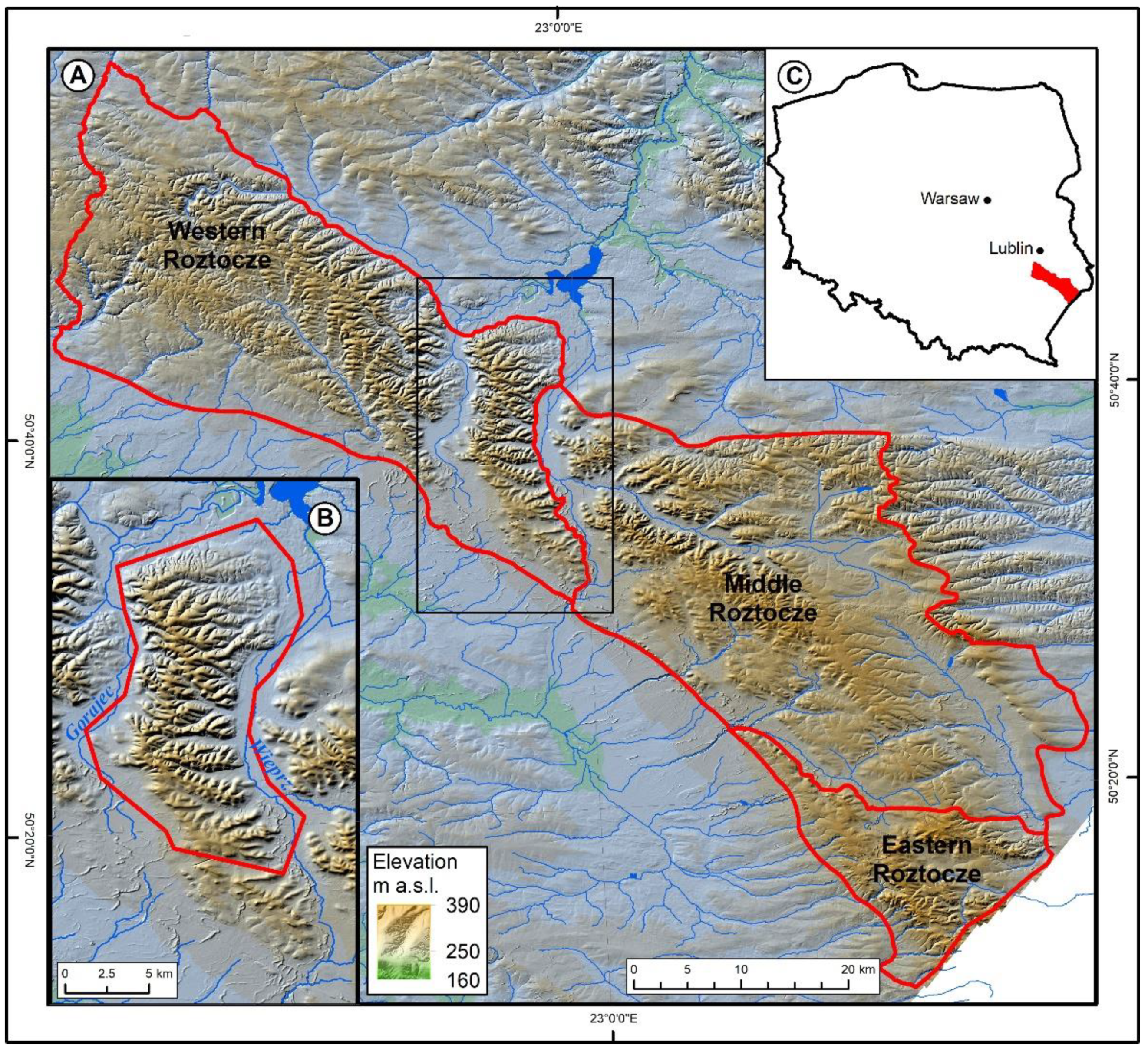
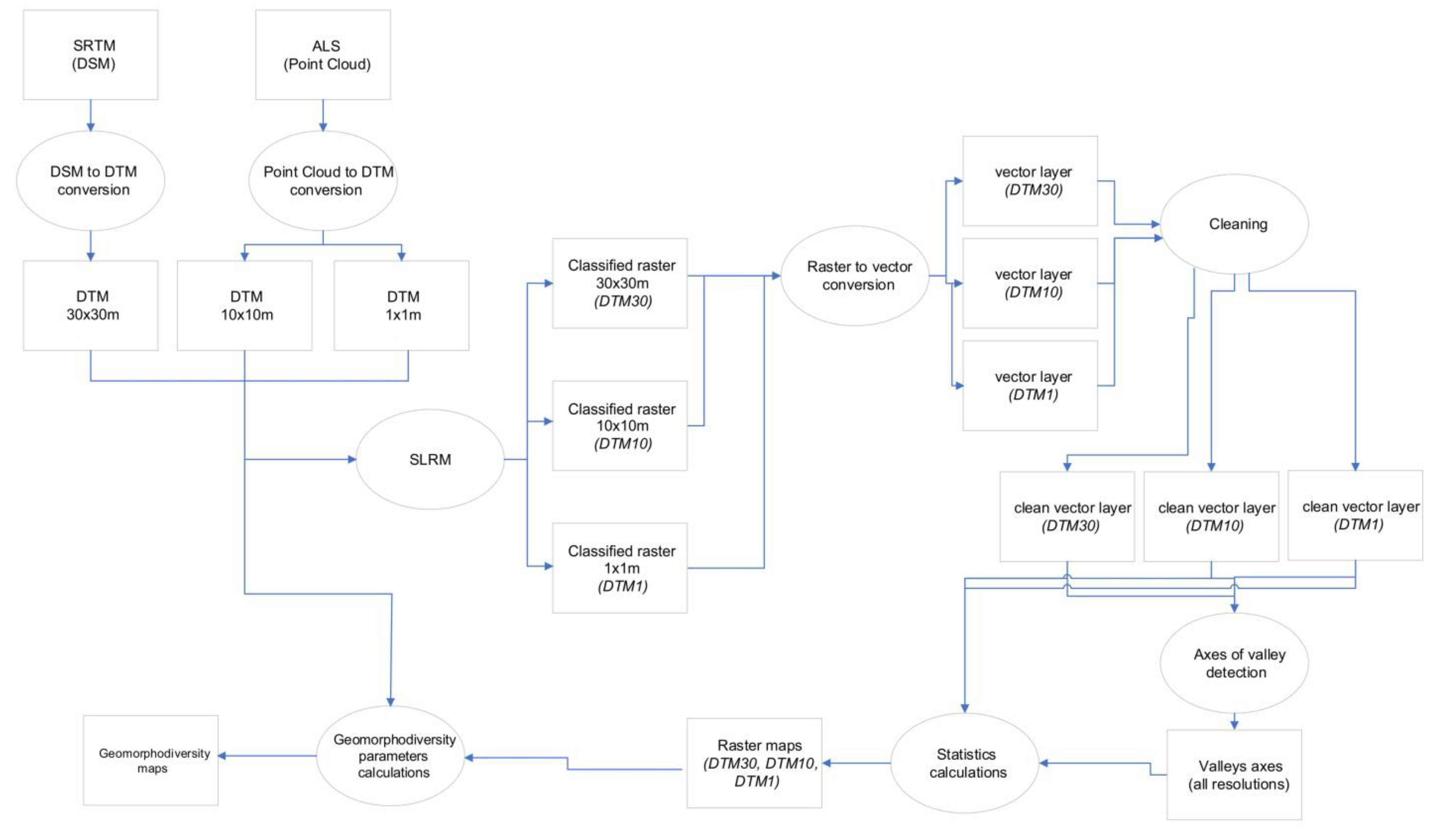
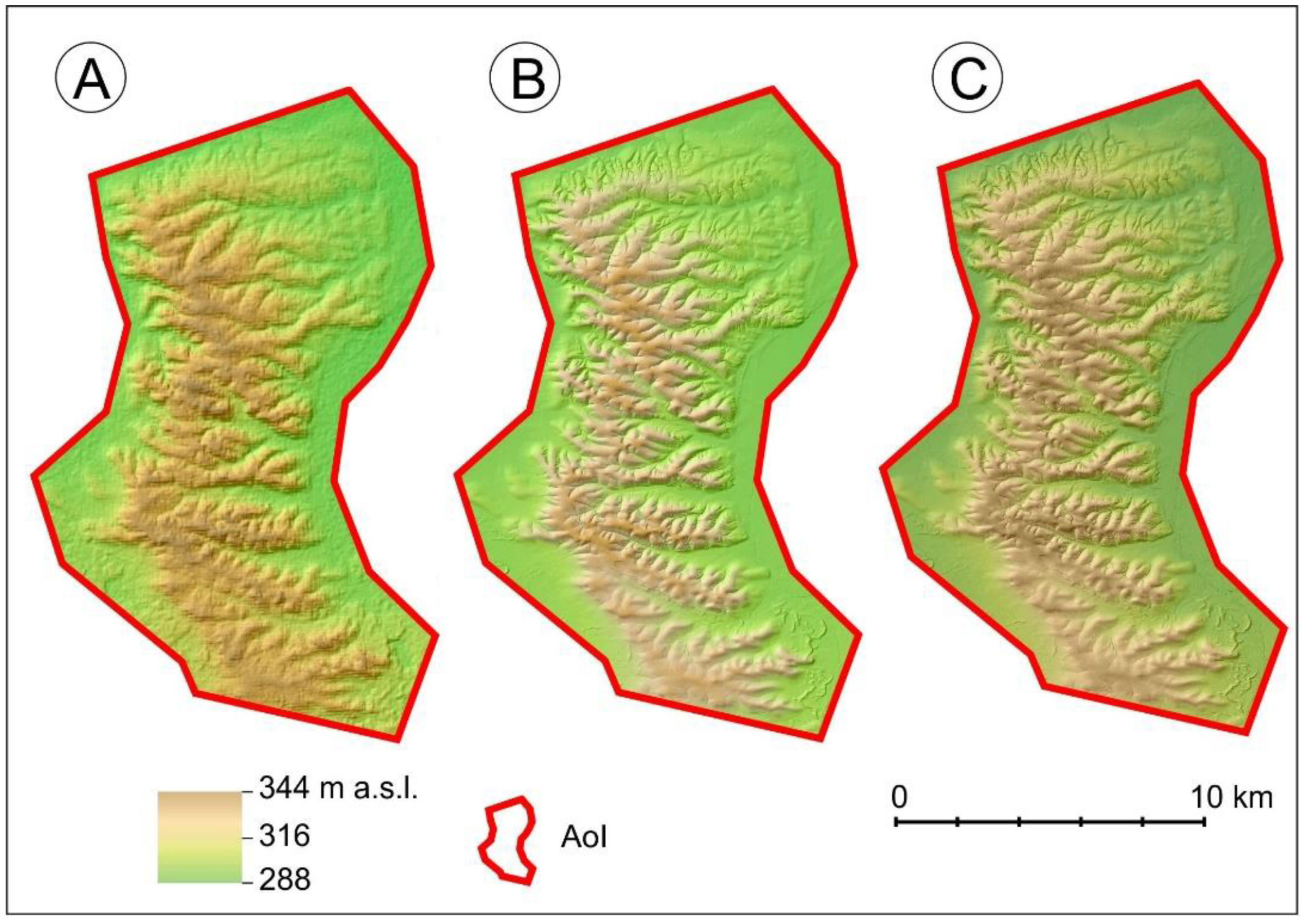
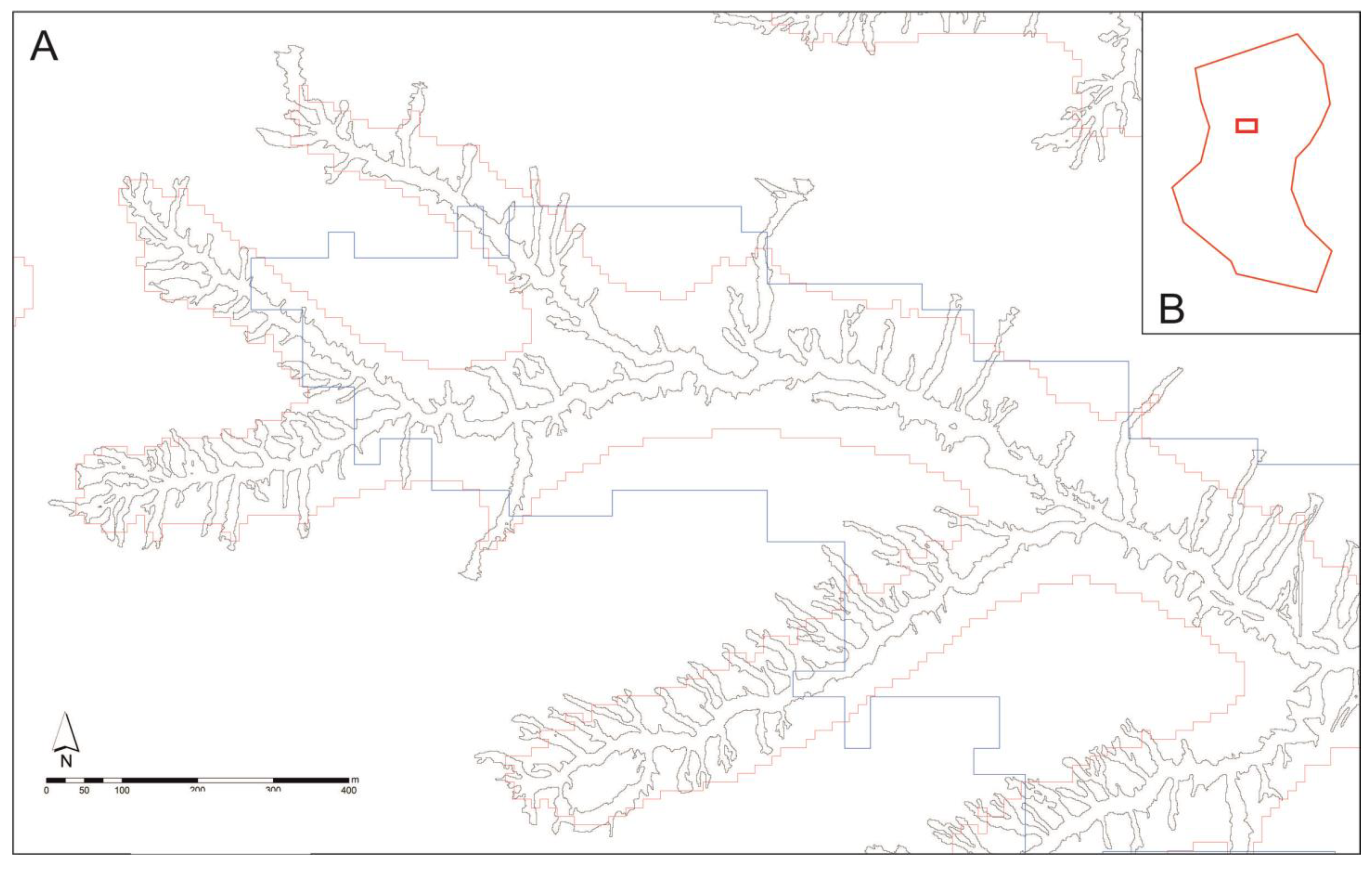


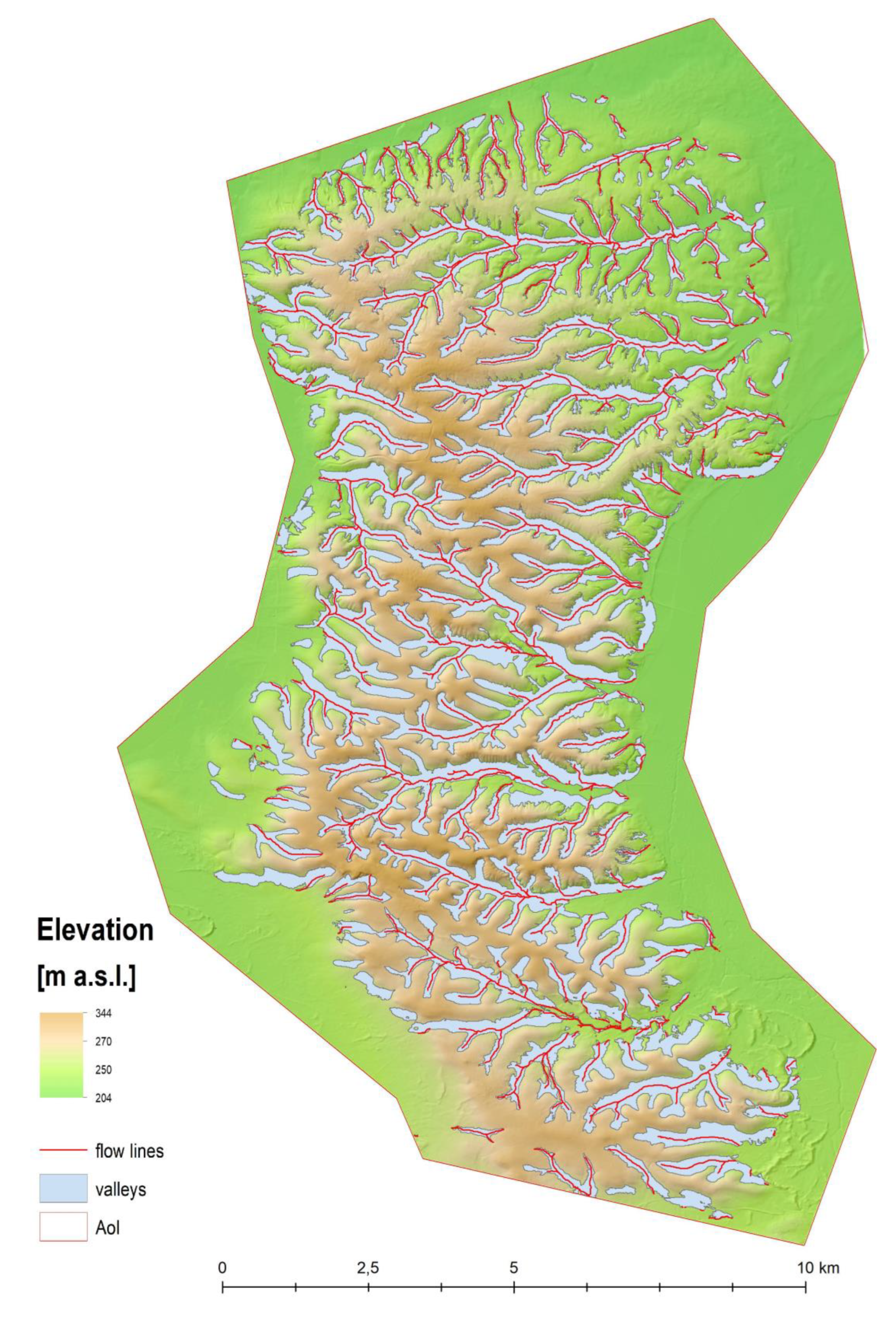
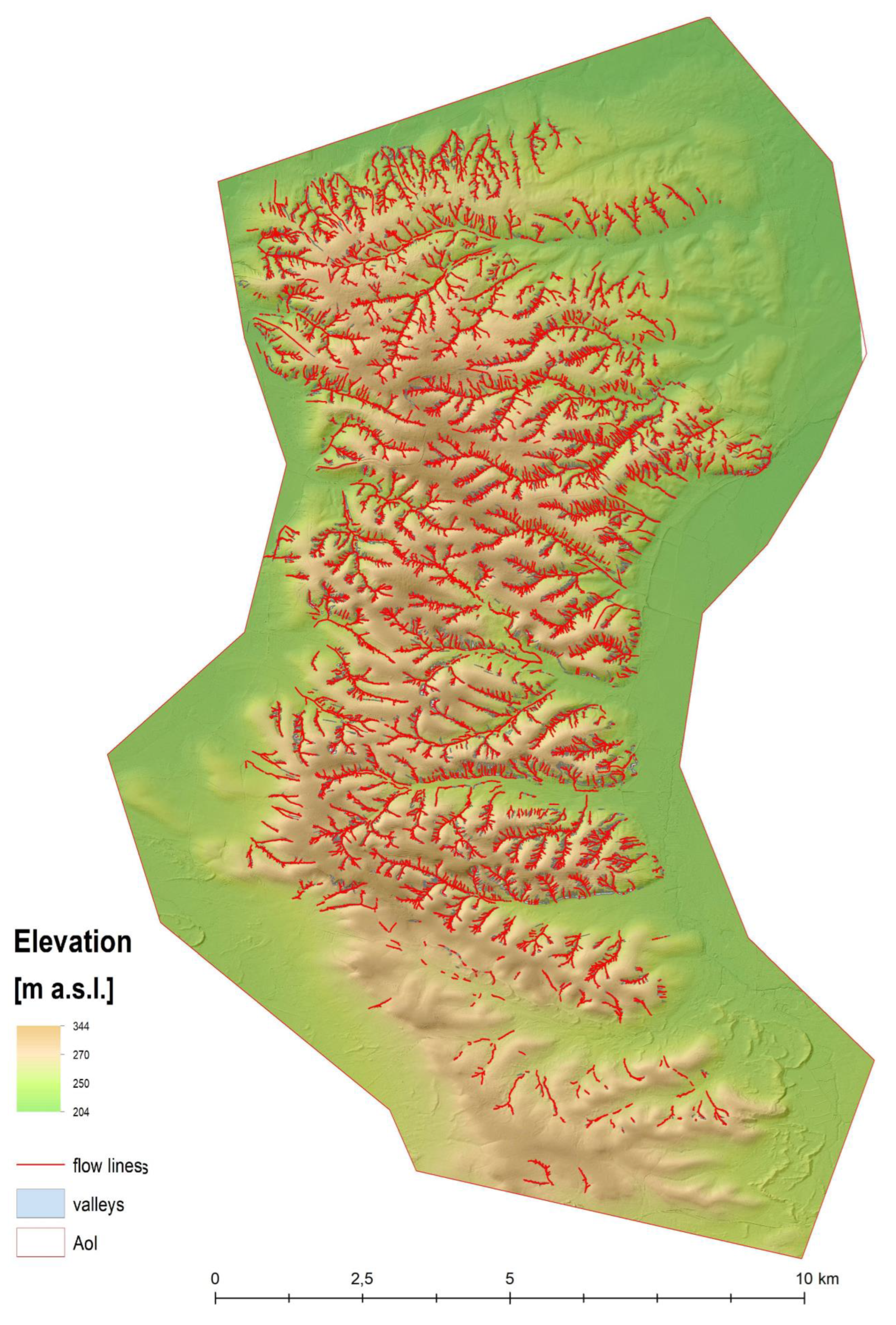
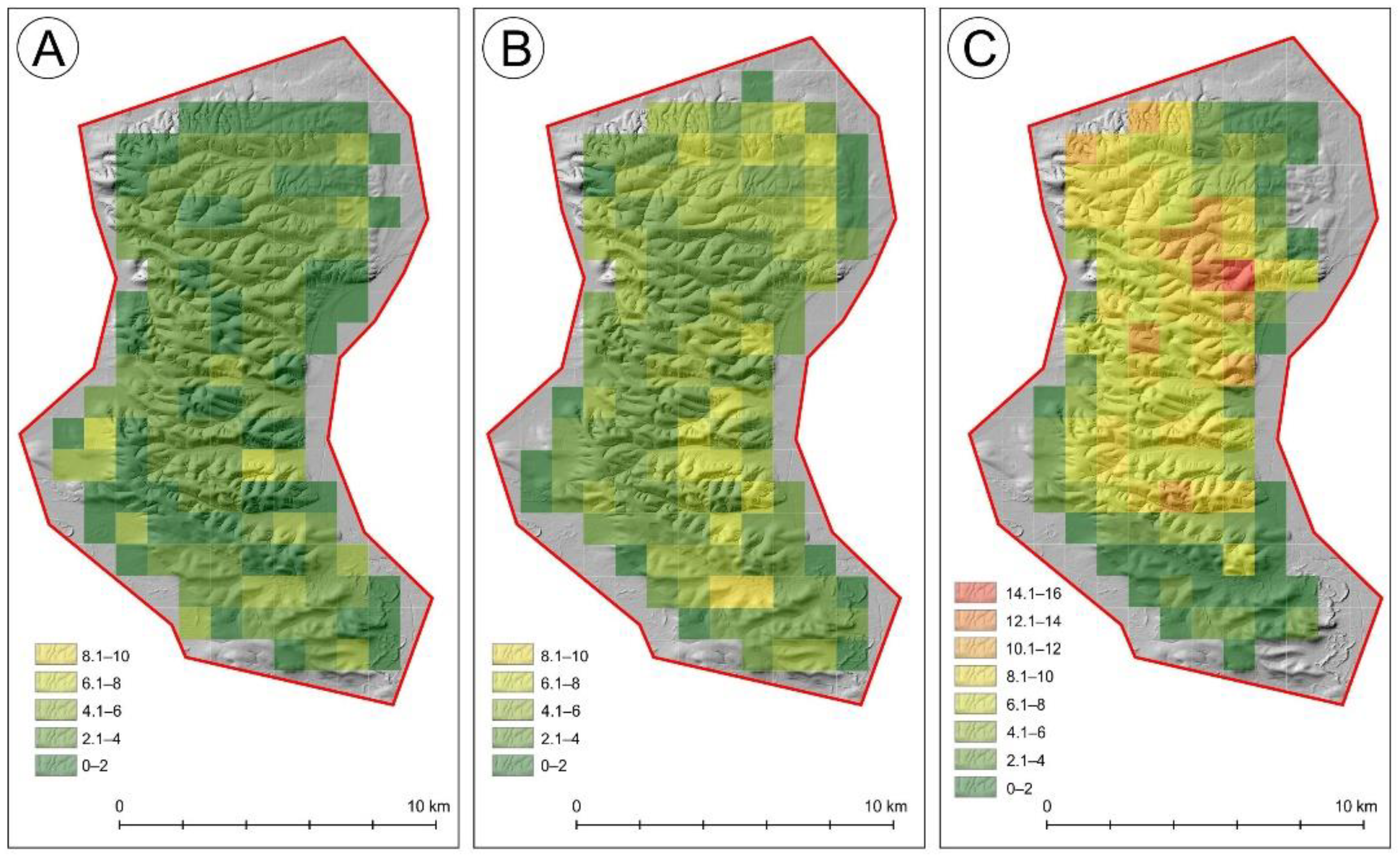
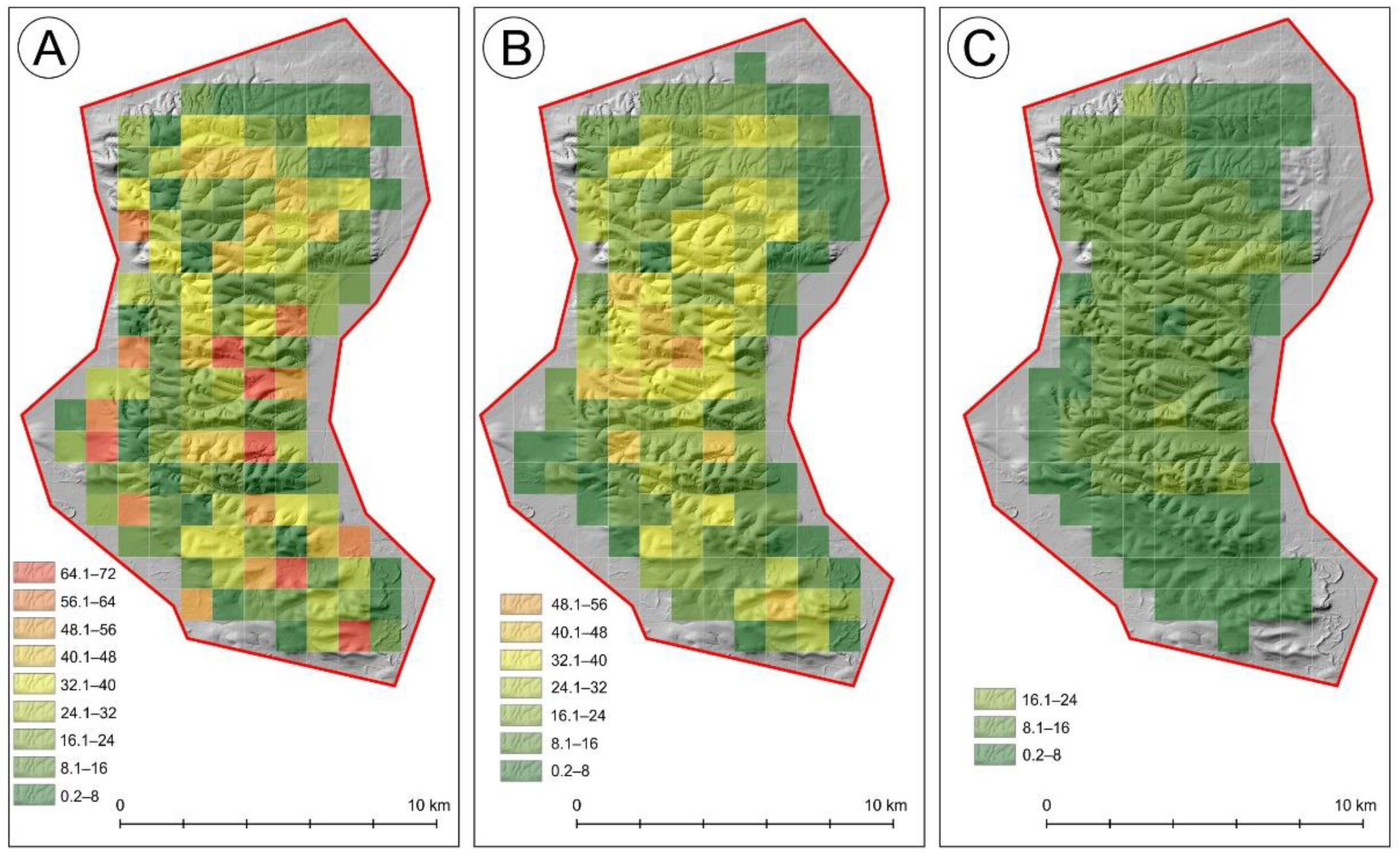
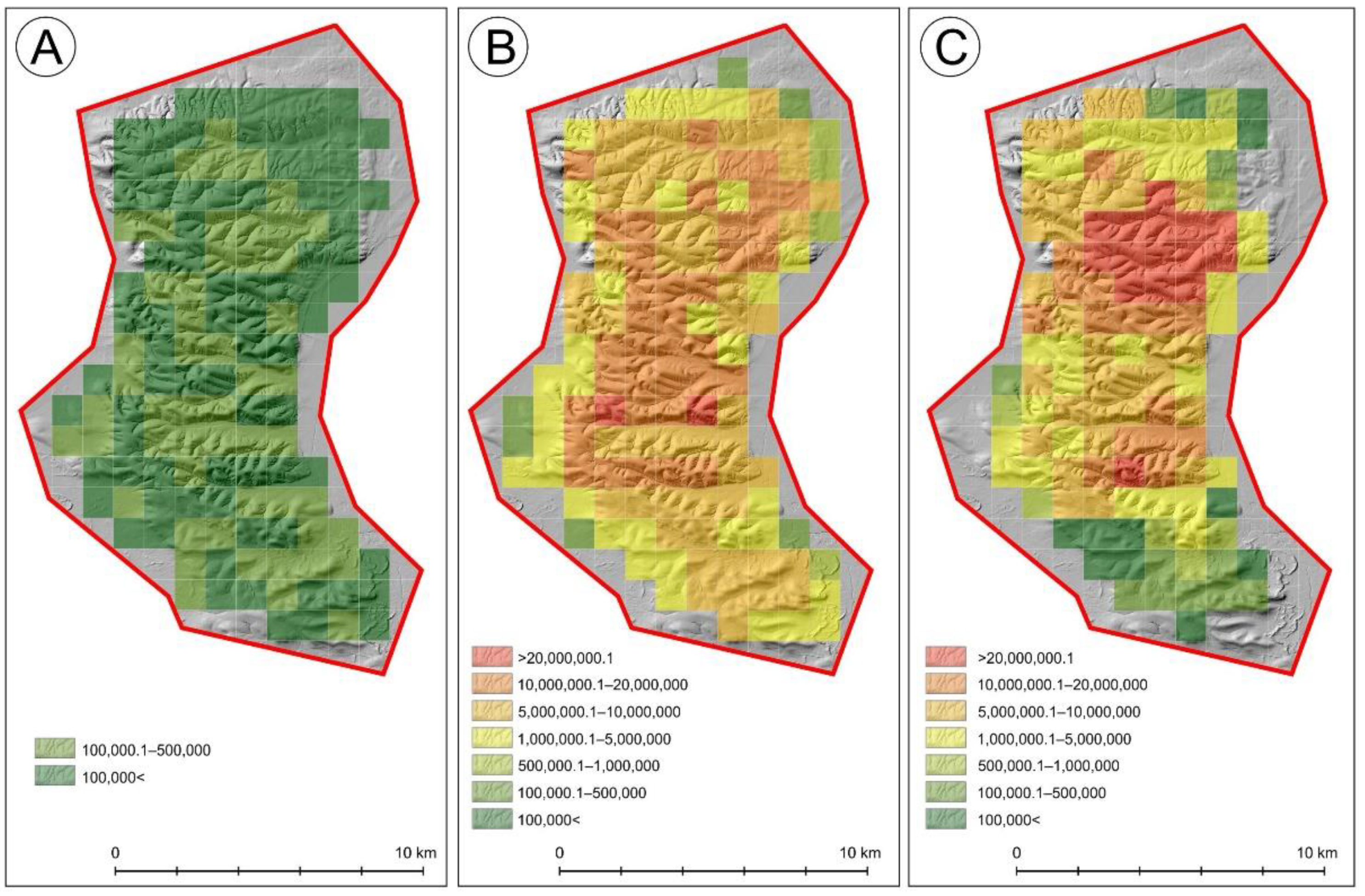
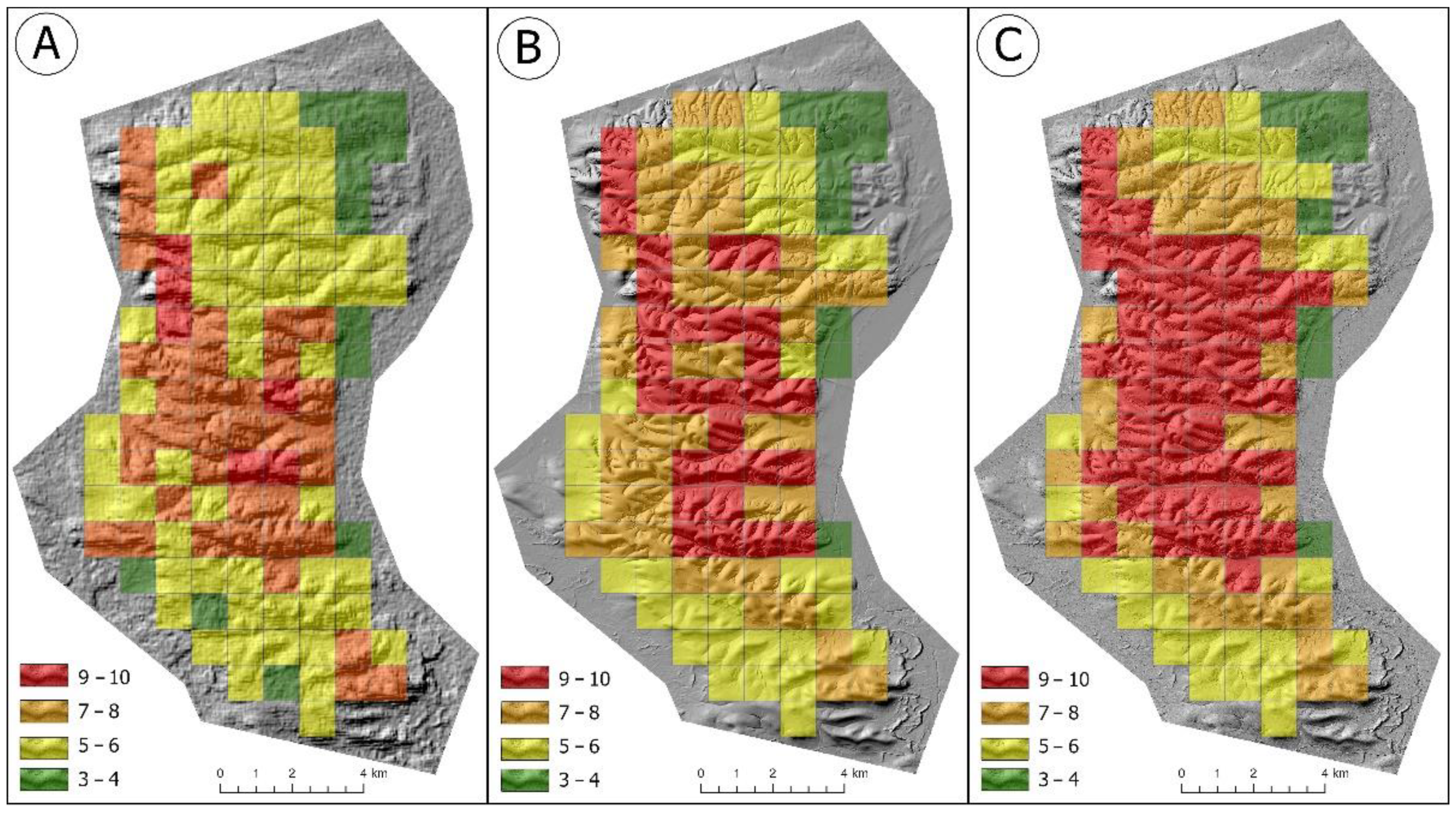
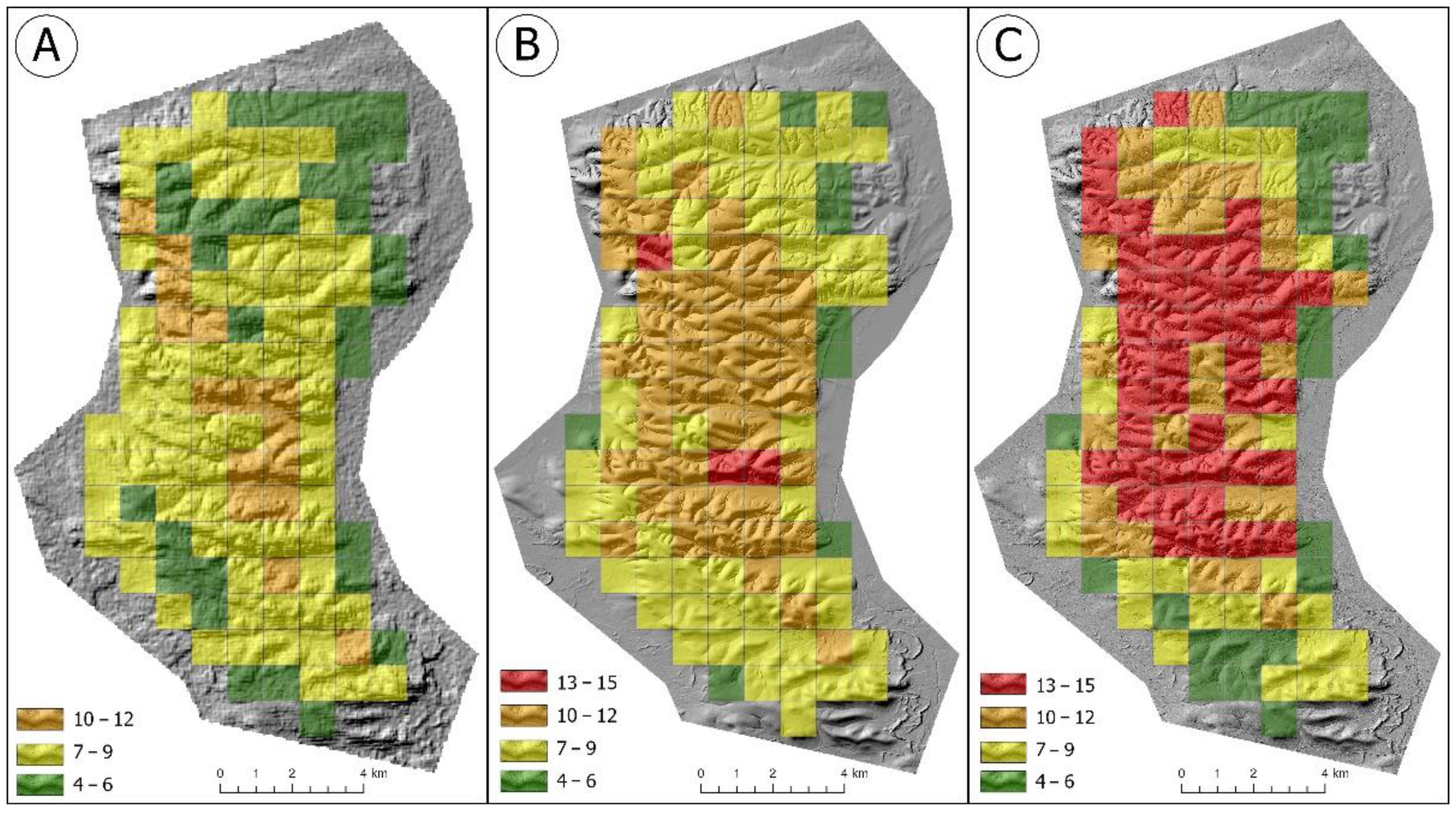
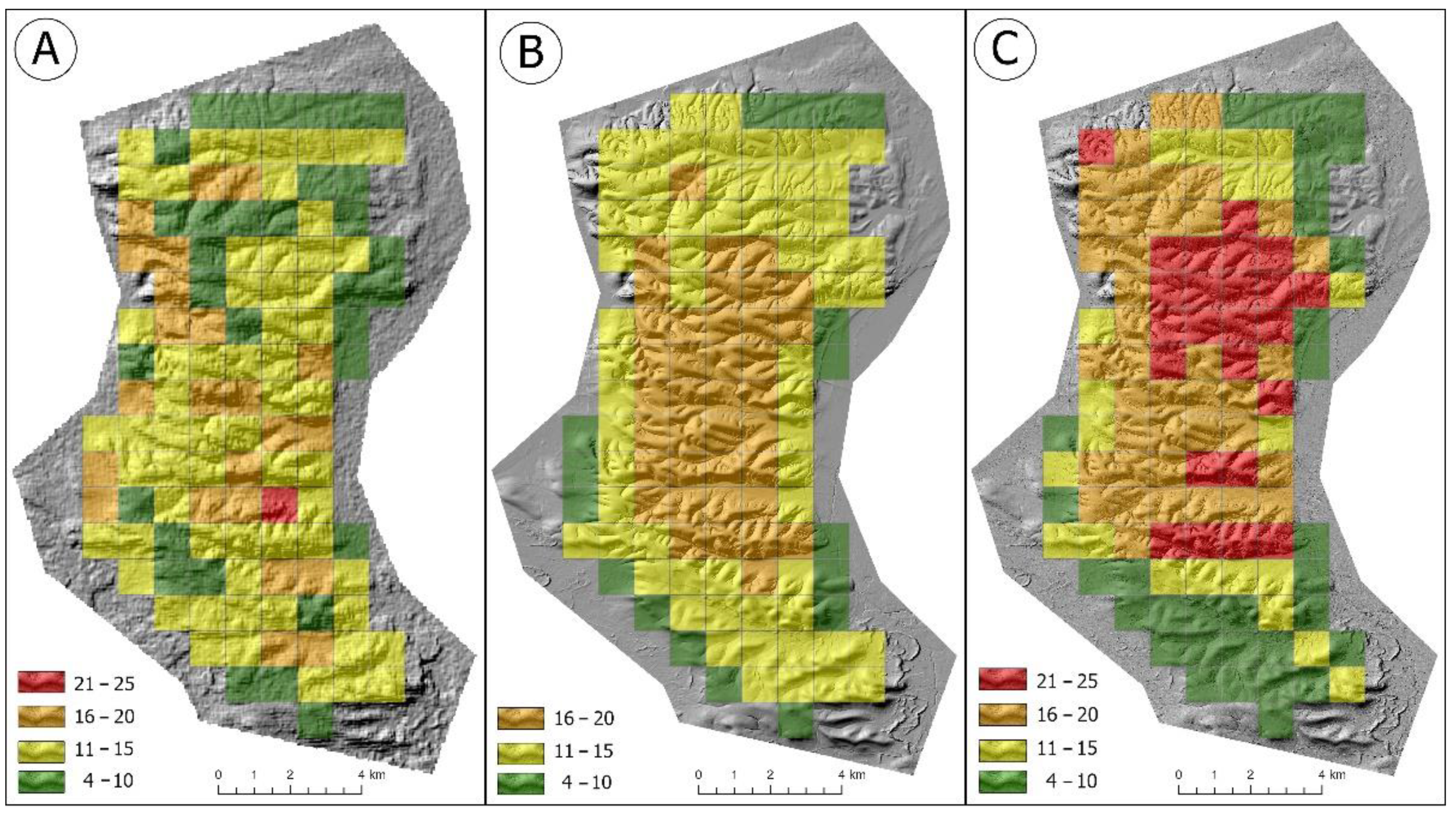
| Index/DTM | DTM30 | DTM10 | DTM1 | Geomorpho-Diversity Subvalue |
|---|---|---|---|---|
| Relative Height | <20 20.1–40.0 40.1–60.0 60.1–80.0 >80.1 | <20 20.1–40.0 40.1–60.0 60.1–80.0 >80.1 | <20 20.1–40.0 40.1–60.0 60.1–80.0 >80.1 | 1 2 3 4 5 |
| Mean Slope (%) | <5.0 5.1–10.0 10.1–15.0 15.1–20.0 >20.1 | <5.0 5.1–10.0 10.1–15.0 15.1–20.0 >20.1 | <5.0 5.1–10.0 10.1–15.0 15.1–20.0 >20.1 | 1 2 3 4 5 |
| GD | <2.5 2.5–5.0 5.1–7.5 7.6–10.0 >10.1 | <2.5 2.5–5.0 5.1–7.5 7.6–10.0 >10.1 | <2.5 2.5–5.0 5.1–7.5 7.6–10.0 >10.1 | 1 2 3 4 5 |
| RVA | <15.0 15.1–30.0 30.1–45.0 45.1–60.0 >60.1 | <10.0 10.1–20.0 20.1–30.0 30.1–40.0 >40.1 | <4.0 4.1–8.0 8.1–12.0 12.1–16.0 >16.1 | 1 2 3 4 5 |
| AVC | <40,000 40,001–80,000 80,001–120,000 120,001–160,000 >160,001 | <5,000,000 5,000,001–10,000,000 10,000,001–15,000,000 15,000,001–20,000,000 >20,000,001 | <5,000,000 5,000,001–10,000,000 10,000,001–15,000,000 15,000,001–20,000,000 >20,000,001 | 1 2 3 4 5 |
| Unit | DTM30 | DTM10 | DTM1 | |
|---|---|---|---|---|
| number of valley/gullies | n | 120 | 434 | 1237 |
| total length | km | 365.61 | 258.17 | 1975.51 |
| mean length | km | 1.39 | 2.17 | 0.27 |
| max length | km | 39.27 | 39.93 | 44.80 |
| min length | km | 0.01 | 0.004 | 0.001 |
| median length | km | 0.07 | 0.32 | 0.03 |
| total area | km2 | 48.10 | 42.72 | 10.30 |
| mean area | km2 | 0.40 | 0.10 | 0.01 |
| max area | km2 | 6.60 | 3.90 | 0.54 |
| min area | km2 | 0.01 | 0.001 | 0.001 |
| median area | km2 | 0.002 | 0.0002 | 0.001 |
| total volume | m3 | 13,150,512.56 | 1,058,032,348.60 | 1,027,728,663.70 |
| mean volume | m3 | 109,571.50 | 251,937.4 | 188,523.4 |
| max volume | m3 | 1,832,730.00 | 10,205,790.3 | 20,579,213.0 |
| min volume | m3 | 0.03 | 66.8 | 48.1 |
| median volume | m3 | 470.00 | 471.9 | 6530.3 |
| GD | Units | DTM30 | DTM10 | DTM1 |
|---|---|---|---|---|
| mean | km/km2 | 2.4 | 3.8 | 5.7 |
| max | km/km2 | 6.3 | 10.0 | 14.5 |
| min | km/km2 | 0.1 | 0.5 | 0.1 |
| median | km/km2 | 2.3 | 3.6 | 6.3 |
| RVA | Units | DTM30 | DTM10 | DTM1 |
|---|---|---|---|---|
| mean | % | 24.9 | 20.5 | 8.3 |
| max | % | 71.8 | 54.3 | 20.5 |
| min | % | 0.2 | 0.1 | 0.1 |
| median | % | 19.4 | 18.4 | 9.5 |
| AVC | Units | DTM30 | DTM10 | DTM1 |
|---|---|---|---|---|
| mean | m3/km2 | 87,466.0 | 7,382,856.3 | 8,509,211.9 |
| max | m3/km2 | 198,217.0 | 21,099,856.0 | 45,345,916.0 |
| min | m3/km2 | 593.0 | 130,950.1 | 1043.9 |
| median | m3/km2 | 87,488.0 | 7,791,656.3 | 5,219,337.0 |
Disclaimer/Publisher’s Note: The statements, opinions and data contained in all publications are solely those of the individual author(s) and contributor(s) and not of MDPI and/or the editor(s). MDPI and/or the editor(s) disclaim responsibility for any injury to people or property resulting from any ideas, methods, instructions or products referred to in the content. |
© 2023 by the authors. Licensee MDPI, Basel, Switzerland. This article is an open access article distributed under the terms and conditions of the Creative Commons Attribution (CC BY) license (https://creativecommons.org/licenses/by/4.0/).
Share and Cite
Siłuch, M.; Kociuba, W.; Gawrysiak, L.; Bartmiński, P. Assessment and Quantitative Evaluation of Loess Area Geomorphodiversity Using Multiresolution DTMs (Roztocze Region, SE Poland). Resources 2023, 12, 7. https://doi.org/10.3390/resources12010007
Siłuch M, Kociuba W, Gawrysiak L, Bartmiński P. Assessment and Quantitative Evaluation of Loess Area Geomorphodiversity Using Multiresolution DTMs (Roztocze Region, SE Poland). Resources. 2023; 12(1):7. https://doi.org/10.3390/resources12010007
Chicago/Turabian StyleSiłuch, Marcin, Waldemar Kociuba, Leszek Gawrysiak, and Piotr Bartmiński. 2023. "Assessment and Quantitative Evaluation of Loess Area Geomorphodiversity Using Multiresolution DTMs (Roztocze Region, SE Poland)" Resources 12, no. 1: 7. https://doi.org/10.3390/resources12010007
APA StyleSiłuch, M., Kociuba, W., Gawrysiak, L., & Bartmiński, P. (2023). Assessment and Quantitative Evaluation of Loess Area Geomorphodiversity Using Multiresolution DTMs (Roztocze Region, SE Poland). Resources, 12(1), 7. https://doi.org/10.3390/resources12010007







